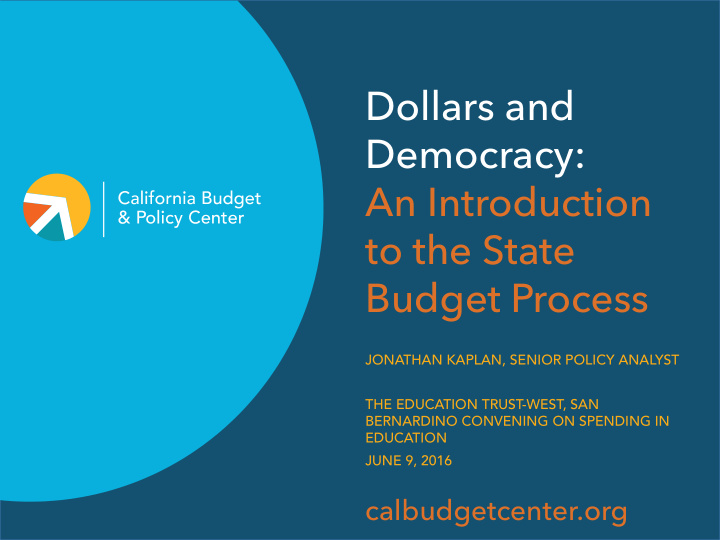



Dollars and Democracy: An Introduction to the State Budget Process JONATHAN KAPLAN, SENIOR POLICY ANALYST THE EDUCATION TRUST-WEST, SAN BERNARDINO CONVENING ON SPENDING IN EDUCATION JUNE 9, 2016 calbudgetcenter.org
Goals of the Presentation • Highlight key terms and definitions about the state budget process in California • Describe the constitutional framework for the state budget process • Review the budget process timeline, including the Governor’s role and the Legislature’s role • Discuss when and how members of the public can get involved | 2
The state budget expresses our values and priorities. | 3
The state budget = state funds + federal funds. | 4
State Funds Account for Nearly Two-Thirds of California’s State Budget Total Proposed 2016-17 Expenditures = $262.6 Billion Federal Funds 35.0% State General Fund 46.7% State Bond Funds 1.2% State Special Funds 17.1% | 5 Source: Department of Finance
The state budget supports a range of public services and systems. | 6
More Than 7 in 10 State Dollars Support Health and Human Services or Education Proposed 2016-17 General Fund and Special Fund Expenditures = $167.6 Billion Health and 31.3% Human Services K-12 Education 30.6% Higher Education 8.7% Corrections 7.9% Other 6.3% Transportation 6.1% Environment and 4.7% Natural Resources Legislative, Executive, 4.4% and Judicial $0 $5 $10 $15 $20 $25 $30 $35 | 7 Source: Department of Finance
The Personal Income Tax Is Projected to Account for Two-Thirds of California’s General Fund Revenues Projected 2016-17 General Fund Revenues = $123.4 Billion Other 2.6% Corporate Income Tax 8.9% Sales and Use Tax 20.9% Personal Income Tax 67.6% Note: Reflects total projected General Fund revenues before a $1.3 billion transfer to the state’s rainy day fund as required by Proposition 2, the ballot measure passed by voters in November 2014, and an additional $2 billion transfer proposed by the Governor. | 8 Source: Department of Finance
Expiration of Proposition 30’s Personal Income Tax Rate Increases Would Leave Permanent Gap in State Revenues General Fund Revenues Before Transfers to the Budget Stabilization Account, in Billions $7.7 Potential Additional General Fund Revenues if Proposition 30 Were Extended $4.5 $133.3 Projected General Fund $129.0 Revenues Assuming $127.9 Proposition 30 Expires $123.4 $118.8 Note: 2015-16 is estimated; 2016-17 onward are projected. Additional revenues for 2018-19 and 2019-20 assume that personal income tax (PIT) revenue growth under an extended Prop. 30 would reflect the Administration’s projected underlying PIT growth rate absent Prop. 30 taxes. | 9 Source: Department of Finance (DOF); Budget Center calculations based on DOF data
The State Budget Process: Key Terms and Definitions | 10
Speaking the Language • Governor’s Proposed Budget: – Shows spending for the prior and current fiscal years and proposed spending for the upcoming fiscal year. • Governor’s Budget Summary: – Provides the Governor’s economic and revenue outlook, highlights major policy initiatives, and summarizes state expenditures assumed in the proposed budget. • May Revision: – Updates the Governor’s economic and revenue outlook and revises, supplements, or withdraws policy initiatives included in the Governor’s proposed budget. | 11
Speaking the Language (continued) • Department of Finance (DOF): – Prepares the Governor’s budget documents. The DOF director is the Governor’s chief fiscal adviser. • Assembly Budget Committee and Senate Budget and Fiscal Review Committee: – Review the Governor’s proposals and help develop the Legislature’s version of the budget. Committee analyses are released beginning in January. • Legislative Analyst’s Office (LAO): – Provides fiscal and policy advice to the Legislature. LAO budget analyses are released beginning in January. | 12
The “budget package” consists of the budget bill and budget-related bills. | 13
The state Constitution establishes the rules of the budget process. | 14
The state Constitution sets two budget-related deadlines: January 10 and June 15. | 15
The budget bill and most budget-related bills can be passed by a simple majority vote. (Proposition 25 of 2010) | 16
A supermajority (two-thirds) vote is needed to approve any tax increase. (Proposition 26 of 2010) | 17
Proposition 26 added this key phrase to the state Constitution: “Any change in state statute which results in any taxpayer paying a higher tax” requires a two-thirds vote of each house of the Legislature. | 18
The state Constitution contains complex formulas that establish state budget priorities. | 19
K-14 education is guaranteed a minimum level of funding. (Proposition 98 of 1988) | 20
Some state revenues must be set aside to pay down debts and save for a rainy day. (Proposition 2 of 2014) | 21
The budget process is cyclical, not linear. Decisions are made throughout the year, both in public settings and behind the scenes. | 22
Recommend
More recommend